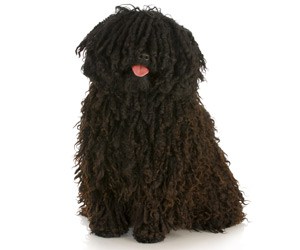The corded coat of the Hungarian Puli is a natural formation. Over time, the weather-resistant topcoat becomes entwined with the softer undercoat, forming cords, of which there are various types. The fully corded coat takes a long time to develop. For example, a floor-length coat can take up to five years to grow. Therefore, it is a must to remember that the first part of the cord will be there for a considerable time!
The Puli coat colors are black, sometimes with a rusty appearance, white and shades of apricot and gray. The cords fall into various types: tight, narrow, round cords; looser, thicker, round cords; wide, flatter, ribbon cords; and narrow, flatter, ribbon cords. The main thing is that the cords are of similar type all over the Puli, with slightly thinner, shorter cords on the head and ears.
MAINTENANCE: A floor-length show coat will require a great deal of regular grooming and much care to ensure that the cords are preserved. It should be remembered that the dog’s coat has developed for a reason — a Hungarian Puli working in a natural environment has a corded coat to protect it from extreme weather as well as hazards.
PROCEDURE
Equipment needed: Basic grooming is done with the thumb and fingers, but a good pair of scissors, a brush, a comb and a hair-dryer will be useful.
Breed tip: Make sure the cords are separated regularly and that the coat does not gather too much debris, which can cause irritation to the dog.
- Care is required from a young age, when a soft (baby) hairbrush can be used, both to get the puppy used to being handled and also to massage the skin.
- Once cord formation is seen to start in a young dog, the brush is put to one side, but it is a good idea to continue massaging the skin with your fingers. Tufts close to the skin (or small “rat tails”) are the first sign of cording. From the onset of cording until the cords have become firmer and reasonably tight is undoubtedly the worst period of time to care for the coat. Grooming depends on the type of coat — especially the amount of undercoat there is, as it is this that can cause bad felting in the cords. It is important to ensure that the cords are separated to the skin and that there is a good amount of air circulation. Separate the cords using a spray of baby oil and water.
- The coat should be bathed regularly using a good canine shampoo. It should be rinsed and rinsed again to ensure that all residues have been removed.
- Natural drying will take considerable time. A cage is a must, as are numerous towels. A canine hair-dryer helps to speed things along, but the drying process can still take a considerable period of time as the cords are quite spongelike.
- After the coat is dry, a mixture of one-third baby oil to two-thirds water can be finely sprayed, directly onto the coat. This spray can be used between baths to help tighten up the coat.
- Check the dog’s nails, ears and teeth. The ears can become very matted with the coat, inside and on the leathers. Care must be taken to make sure this is not allowed to become a solid mat.
- Check the beard, around the mouth and the eyes. Often, food can get caught in the beard — sometimes it is possible to get this out by using a comb, or the beard can be short-trimmed.
- Check the paws, including between the pads. Trim to remove any mats found on the feet, as well as any excess coat or long cords that might cause the dog to trip when walking or running.
- A long coat may well require trimming if it becomes too long.

